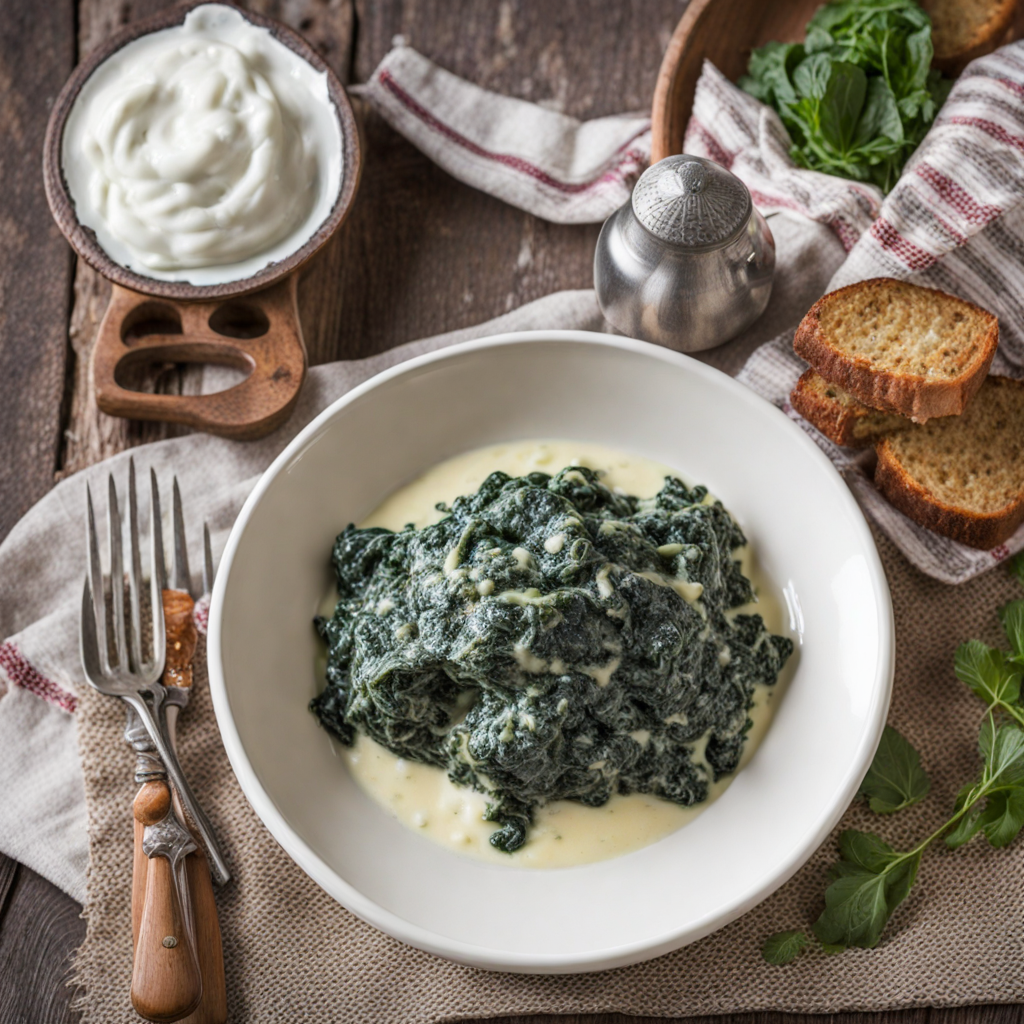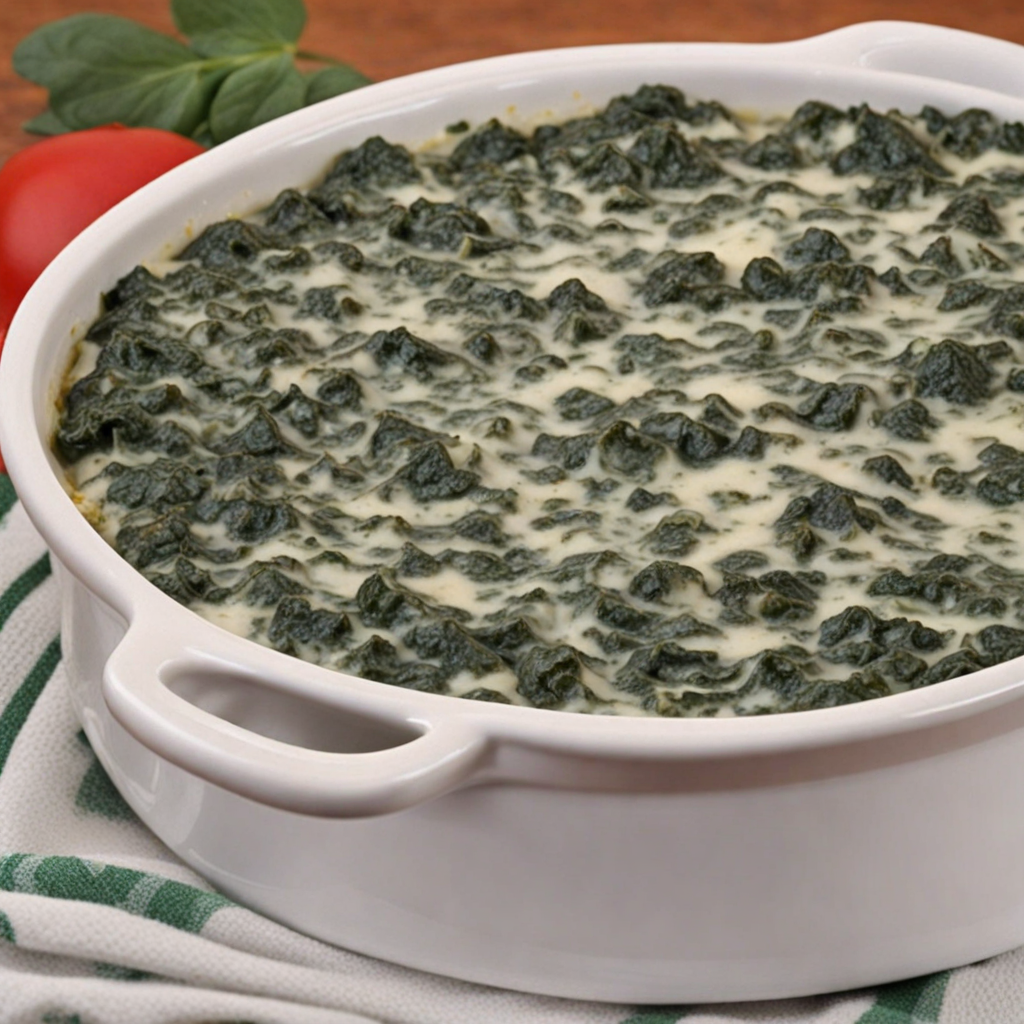Hungarian Creamed Spinach
Hungarian Creamed Spinach is a delightful dish that showcases the rich culinary heritage of Hungary, combining the earthiness of fresh spinach with a luscious, creamy sauce. The spinach is typically sautéed to perfection, allowing its vibrant green color and slightly sweet flavor to shine. The dish is often enhanced with a blend of spices, such as paprika, which adds a subtle warmth and depth to the overall taste profile. The balance of flavors makes it a versatile side dish, perfect for pairing with hearty meats or served alongside traditional Hungarian dishes. The cream sauce used in Hungarian Creamed Spinach is usually made from a base of sour cream or heavy cream, giving it a velvety texture that coats the spinach beautifully. This creamy element is sometimes enriched with additional ingredients like garlic, onions, or even a hint of cheese, creating layers of flavor that elevate the dish. The result is a comforting and indulgent experience, where the creaminess melds seamlessly with the tender greens, making each bite both satisfying and nostalgic. As you explore this dish, you will find that Hungarian Creamed Spinach is not just a simple vegetable preparation; it is a celebration of traditional Hungarian cooking. It embodies the country's love for rich, hearty flavors while remaining light and refreshing thanks to the spinach. Whether enjoyed as part of a festive meal or a cozy family dinner, this dish promises to introduce your palate to a new and exciting taste that reflects the essence of Hungarian cuisine.
How It Became This Dish
The History of Főzelék: A Culinary Gem of Hungary #### Origins of Főzelék Főzelék is a quintessential Hungarian dish that embodies the essence of Hungarian comfort food. Its roots can be traced back to the peasant cuisine of the 19th century, a time when simple, hearty meals were essential for nourishment. The term "főzelék" itself comes from the Hungarian verb "főzni," meaning "to cook," and it refers to a thick vegetable stew or purée often served as a side dish or a main course. Historically, Hungarian cuisine has been characterized by its use of seasonal ingredients and local produce. The fertile lands of Hungary, rich in vegetables such as potatoes, beans, peas, and various greens, contributed to the emergence of főzelék as a staple in the diet of the Hungarian populace. In a society where meat was often too expensive for everyday meals, főzelék provided a nutritious alternative that showcased the versatility of vegetables. #### Cultural Significance Főzelék is not just a dish; it holds a special place in Hungarian culture. It reflects the agricultural heritage and the traditional values of Hungarian society, where cooking was often a communal activity. Families would gather to prepare meals together, and the act of making főzelék often became a time for bonding and sharing stories. This dish has transcended its humble beginnings and has become a symbol of home-cooking in Hungary. It is frequently served in homes and is a common feature in school cafeterias and restaurants. The dish embodies the philosophy of "jó étvágyat" (bon appétit) and represents the comfort, warmth, and hospitality that characterize Hungarian culture. Főzelék also plays a role in the culinary identity of Hungary. It is a dish that can be found in numerous variations across the country, with each region putting its unique spin on the recipe. This diversity speaks to the adaptability of Hungarian cuisine, as local ingredients and cooking methods have influenced the preparation of főzelék over the years. #### Development Over Time The evolution of főzelék can be traced through various historical milestones in Hungary. During the Austro-Hungarian Empire, from the late 19th century to the early 20th century, Hungary experienced significant cultural and culinary exchange. As urbanization increased, the traditional peasant foods began to intermingle with more refined culinary techniques. This period saw the introduction of new ingredients and spices, which allowed for the development of more complex flavors in dishes like főzelék. The post-World War II era brought about significant changes to Hungarian cuisine, as the country faced economic hardships and food shortages. During this time, főzelék became even more important as a means of sustenance. Cooks embraced creativity, utilizing whatever vegetables were available and often rationing ingredients. The dish became a canvas for improvisation, and recipes began to vary widely, incorporating whatever was on hand, from spinach and carrots to lentils and cabbage. In the later decades of the 20th century, as Hungary began to open up to the world, international influences began to seep into Hungarian culinary practices. Restaurants started to feature more elaborate interpretations of traditional dishes, while home cooks continued to embrace the simplicity of the original recipes. Főzelék was often reimagined in urban settings, showcasing a blend of traditional and contemporary techniques. #### Ingredients and Variations The beauty of főzelék lies in its adaptability. While the base of the dish typically consists of vegetables, the choice of ingredients can vary significantly depending on the season and regional availability. Common vegetables used in főzelék include potatoes, peas, spinach, carrots, and beans. The preparation usually involves cooking the vegetables until soft and then thickening the mixture with a roux made from flour and fat, or sometimes with pureed legumes like lentils or beans. One of the most popular variations is "zöldborsó főzelék," made with green peas and often served with a dollop of sour cream on top. Another beloved version is "burgonya főzelék," which features potatoes and is often complemented by a side of sausage or meat. Each variation reflects the local ingredients and culinary preferences, resulting in a rich tapestry of flavors and textures. #### Főzelék in Modern Times In contemporary Hungary, főzelék has experienced a renaissance as chefs and home cooks alike rediscover the joy of cooking with fresh, locally sourced ingredients. There is a growing movement towards sustainable eating, and many are turning to traditional recipes as a way to honor their culinary heritage while embracing modern dietary practices. Főzelék is often seen as a healthier alternative to more meat-heavy dishes and is increasingly being promoted as a vegetarian or vegan option. Moreover, with the rise of food tourism, főzelék has found its way onto the menus of restaurants seeking to showcase authentic Hungarian cuisine. Chefs have begun to experiment with fusion elements, incorporating international flavors while staying true to the essence of the dish. #### Conclusion Főzelék is more than just a simple vegetable dish; it is a celebration of Hungarian culture and culinary history. From its humble beginnings in peasant kitchens to its status as a beloved dish in modern Hungarian cuisine, főzelék encapsulates the spirit of adaptability and resourcefulness that defines the Hungarian people. It serves as a reminder of the importance of community, tradition, and the joy of sharing a meal with loved ones. As Hungary continues to evolve, so too will főzelék, but its core will always remain rooted in the rich agricultural bounty of the land and the love of home-cooked meals. Whether enjoyed at a family gathering, a school lunch, or a trendy restaurant, főzelék will always hold a cherished place in the hearts—and stomachs—of the Hungarian people.
You may like
Discover local flavors from Hungary







